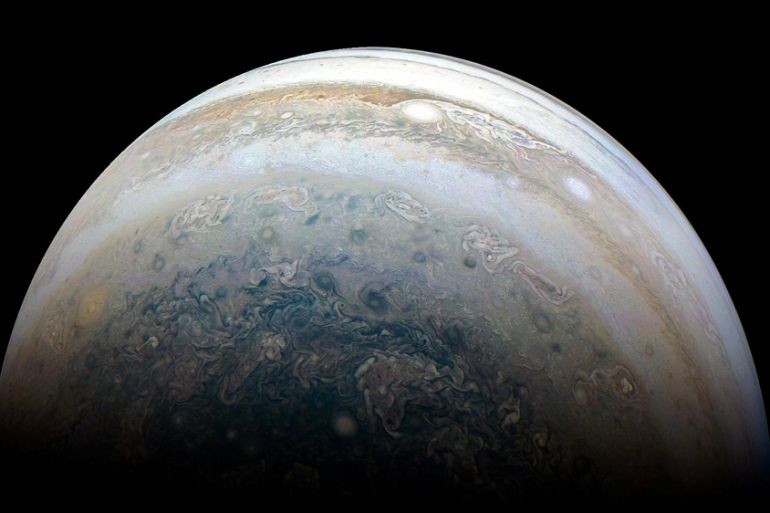Astronomers find 10 new moons around Jupiter, including ‘oddball’
Scientists discovered 10 new moons orbiting Jupiter, the planet now has more moons than any other planet.

Astronomers have announced the discovery of 10 more moons of Jupiter, including one “oddball” that appears destined to crash into other satellites sharing its orbital highway.
The announcement on Tuesday by researchers in the United States brought the total number of the moons known to be circling the giant gas planet to 79.
Keep reading
list of 4 itemsBoeing’s jets turn 70: A timeline of highs, lows and turbulence
US university ties to weapons contractors under scrutiny amid war in Gaza
Scientists discover sperm whale ‘phonetic alphabet’
It means Jupiter, the oldest and largest planet in the solar system, has more moons than any of the other seven.
All the newly identified moons are relatively small, ranging in size from about six-tenths of 1km to 4km. This is in contrast to other Jupiter moons such as Ganymede – the biggest in the solar system with a diameter of 5,268km.
Jupiter, the fifth planet from the Sun, has a diameter of 142,984km.
‘Big vacuum cleaner’
A research team led by astronomer Scott Sheppard of the Carnegie Institution for Science in Washington has identified a total of 12 small moons of Jupiter, including the 10 described on Tuesday.
Sheppard said these moons were probably objects that formed near Jupiter during the early days of the solar system and were “captured” by the planet’s strong gravitational pull.
“Jupiter is like a big vacuum cleaner because it’s so massive,” Sheppard said.
A team led by @CarnegiePlanets' Scott Sheppard has discovered 12 new moons orbiting Jupiter—11 “normal” outer moons, and one that they’re calling an “oddball.” https://t.co/6zRTPsECVU pic.twitter.com/cKWRuMxDbk
— Carnegie Science (@carnegiescience) July 17, 2018
“These objects started orbiting Jupiter, instead of falling into it. So we think they’re intermediate between rocky asteroids and icy comets. So they’re probably half ice and half rock.”
The team is calling one of the new moons an “oddball” because of its unusual orbit. Sheppard’s girlfriend came up with a name for it: Valetudo, the great-granddaughter of the Roman god Jupiter, and the goddess of health and hygiene.
Valetudo orbits Jupiter in the same direction that the planet spins, but a bunch of other small moons share the same orbital path while travelling in the opposite direction.
“Valetudo’s going down the highway the wrong way, so it’s very likely it will collide with these other objects. It probably has collided with them over time,” Sheppard said.
The latest count of 79 known moons of Jupiter includes eight that have not been seen for several years.
Saturn is next with 62, followed by Uranus with 27 and Neptune with 14. Mars has two, Earth has one and Mercury and Venus have none.
Sheppard said Jupiter and Saturn may actually have a similar number of moons, with some of the latter’s smaller ones not yet detected.
Telescopes in Chile and the US states of Hawaii and Arizona were used for the latest discovery and confirmation.
Astronomer Galileo detected Jupiter’s four largest moons – Io, Europa, Ganymede and Callisto – 400 years ago.